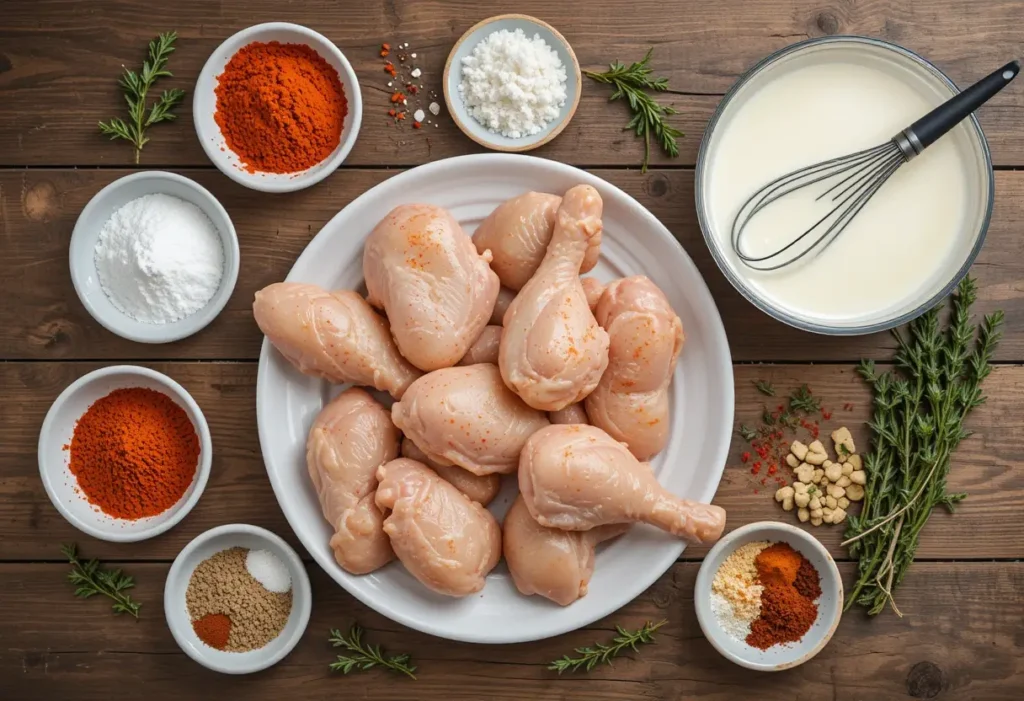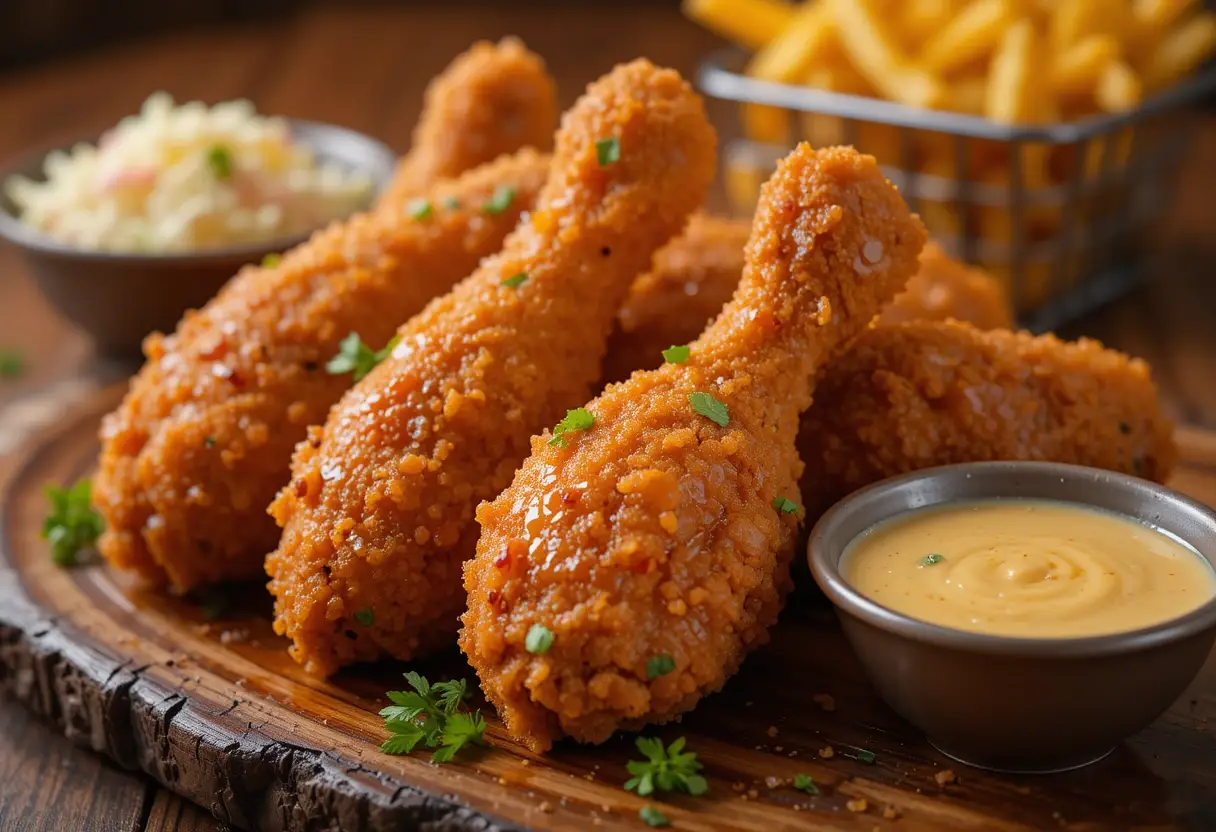Fried chicken legs are a quintessential comfort food loved by people across the globe. Their golden-brown crispy exterior and juicy, flavorful meat make them a favorite for family dinners, picnics, and special gatherings. Whether paired with mashed potatoes, coleslaw, or enjoyed on their own, fried chicken legs offer a satisfying meal that’s hard to resist.

In this guide, we’ll dive deep into the secrets of creating the perfect fried chicken legs, explore why they are so popular, and take a look at their fascinating history in the culinary world.
Table of Contents
What Makes Fried Chicken Legs a Popular Dish?
Fried chicken legs are a staple in many cuisines for several reasons:
- Taste and Texture: The combination of crunchy, seasoned breading and tender, juicy chicken is a match made in heaven. This contrast in textures creates a delightful eating experience.
- Versatility: Fried chicken legs can be seasoned in countless ways, making them adaptable to various culinary traditions, from Southern-style buttermilk chicken to spicy Asian-inspired recipes.
- Easy to Share: Chicken legs are the perfect finger food, making them ideal for parties, picnics, and other social gatherings. They’re easy to cook in large batches and are always a crowd-pleaser.
- Affordable and Accessible: Chicken legs are generally affordable and widely available, making them an accessible choice for cooks of all skill levels.
- Universal Appeal: The flavors of fried chicken legs transcend cultural boundaries, making them a beloved dish in diverse cuisines worldwide.
Brief History of Fried Chicken in Cuisine
Fried chicken has a rich and multicultural history that spans centuries. Its origins are intertwined with culinary traditions from different parts of the world:
- African Influence: The roots of modern fried chicken can be traced back to West African cooking methods. African cooks introduced the practice of deep-frying chicken, often seasoning it with spices to enhance flavor.
- European Adaptations: Scottish immigrants brought their frying techniques to the Americas, where they traditionally fried chicken without seasoning or batter. This method merged with African cooking practices to create the seasoned, battered fried chicken we know today.
- American South: Fried chicken became deeply embedded in Southern American cuisine, particularly during the 19th century. The dish gained popularity due to its convenience, as it could be cooked in advance and eaten cold, making it ideal for outdoor events and picnics.
- Global Spread: Over time, fried chicken traveled across the world, adapting to local tastes. From Korean fried chicken with its sweet and spicy glaze to Jamaican fried chicken seasoned with fiery jerk spices, the dish has become a versatile and global phenomenon.
In the next sections of this guide, we’ll explore the step-by-step process of preparing mouthwatering fried chicken legs and share tips and tricks to ensure perfect results every time. Get ready to transform a simple ingredient into a culinary masterpiece!
Essential Ingredients for Fried Chicken Legs
Creating perfect fried chicken legs begins with the right ingredients. Each component contributes to the flavor, texture, and overall success of the dish. Here’s a breakdown of the essentials you’ll need and tips for choosing the best options.
The Best Chicken Legs for Frying
The star of the dish is, of course, the chicken legs. Here’s how to select and prepare them:
- Quantity: For a family of four, plan for about 8 chicken legs (roughly 2 per person). Adjust quantities based on appetite and servings.
- Freshness: Opt for fresh, plump chicken legs. If frozen, ensure they’re fully thawed before cooking to maintain even frying.
- Skin-on vs. Skinless: Skin-on chicken legs provide a crispy outer layer when fried. Skinless is a lighter option but may lack the same crunch.
- Size Matters: Choose similar-sized pieces to ensure even cooking. Smaller chicken legs will cook faster, while larger ones may require more time.

Spices and Herbs: Creating the Perfect Blend
Spices and herbs are crucial for seasoning the chicken and elevating its flavor. Here’s a suggested blend, with quantities for 8 chicken legs:
- Salt (2 teaspoons): Enhances flavor and tenderizes the meat.
- Black Pepper (1 teaspoon): Adds a subtle heat and balances the flavors.
- Paprika (2 teaspoons): Provides color and a mild smokiness. Smoked paprika can add a deeper flavor profile.
- Garlic Powder (1 teaspoon): Imparts a savory, garlicky note.
- Onion Powder (1 teaspoon): Adds depth and complements the garlic.
- Cayenne Pepper (½ teaspoon): Optional, for those who enjoy a spicy kick.
- Dried Oregano or Thyme (1 teaspoon): Adds a hint of herbal aroma.
- Buttermilk Marinade (optional): Combine 2 cups of buttermilk with 1 teaspoon of salt, soaking the chicken for at least 4 hours. This step tenderizes the meat and enhances flavor.
Feel free to adjust the spice levels to suit your taste preferences.
Choosing Your Coating: Flour, Batter, and Bread Crumbs
The coating creates the crispy, golden-brown crust that makes fried chicken legs so irresistible. Choose your preferred method or combine techniques for unique results:
1. Flour Coating
- All-purpose flour (2 cups): The most traditional coating. It ensures a light, crispy crust.
- Cornstarch (½ cup): Mixing cornstarch with flour creates a crispier, more textured crust.
- Seasoning: Add 1 teaspoon of salt and your preferred spices to the flour for a flavorful coating.
2. Batter
- Eggs (2 large): Whisk eggs with 1 cup of milk to create a wet batter.
- Flour (1 cup): Combine with spices for added flavor.
- Optional: Add a splash of hot sauce or beer to the batter for extra zing.
3. Bread Crumbs
- Panko Bread Crumbs (2 cups): These Japanese-style crumbs create a light, airy, and ultra-crispy crust.
- Seasoning: Mix in Parmesan cheese, paprika, or dried herbs for a gourmet touch.
- Tip: Use bread crumbs as a final layer after dipping the chicken in batter for an extra crunchy texture.
Each method offers a unique texture and flavor. Experiment with combinations like flour and panko or a seasoned batter with a cornstarch mix to find your perfect fried chicken leg coating.
Armed with these essential ingredients and tips, you’re ready to create a dish that’s crispy on the outside, juicy on the inside, and bursting with flavor!
Preparing Your Chicken Legs
Getting your chicken legs ready for frying is an essential step to achieving the perfect balance of flavor, juiciness, and texture. Here’s how to clean, marinate, and coat your chicken for optimal results.
Cleaning and Marinating: Tips for Flavorful Chicken
- Cleaning the Chicken:
- Rinse the chicken legs under cold water to remove any residue. Pat them dry with paper towels.
- Optional: Trim excess fat or skin if desired.
- Marinating for Maximum Flavor:
- Use a buttermilk marinade for tenderness. Combine 2 cups of buttermilk with spices like salt, paprika, garlic powder, and black pepper.
- For a zesty alternative, use a mix of lemon juice, olive oil, and herbs like rosemary and thyme.
- Tips:
- Always marinate chicken in the refrigerator to prevent bacterial growth.
- Seal the chicken and marinade in a zip-top bag or cover the bowl tightly with plastic wrap.
Coating Techniques to Ensure Crispy Texture
The coating is key to achieving a crunchy crust. Follow these techniques for the best results:
- Dredging in Flour:
- Lightly dust the chicken in seasoned flour. Shake off excess to avoid clumps.
- Double Coating:
- For extra crunch, dip the chicken in an egg wash or buttermilk after the first flour coat, then dredge in flour or bread crumbs again.
- Layering with Bread Crumbs:
- If using bread crumbs, press them firmly onto the chicken to ensure they stick.
- Rest Before Frying:
- Allow the coated chicken to rest for 10–15 minutes. This helps the coating adhere better and creates a crispier crust.
Marination Time Frames for Optimal Flavor
The amount of time you marinate your chicken impacts both flavor and texture:
- Quick Marinade (30 minutes): Perfect for last-minute preparations. Provides a subtle flavor boost.
- Standard Marinade (4–6 hours): Enhances tenderness and infuses deep flavor.
- Overnight Marinade (8–12 hours): Ideal for maximum flavor. Be careful not to exceed 24 hours to avoid mushy chicken.
Cooking Techniques
Once your chicken is prepped, it’s time to cook! Choose between traditional deep frying or a healthier air-fried alternative.
Deep Frying vs. Air Frying: Which Is Better?
- Deep Frying:
- Pros: Achieves the crispiest texture with a classic fried flavor.
- Cons: Higher in calories and requires more oil.
- Air Frying:
- Pros: Healthier option with significantly less oil. Easier cleanup.
- Cons: Slightly different texture—less crunchy than deep frying.
Step-by-Step Guide to Deep Frying Chicken
- Heat the Oil:
- Use a deep skillet or fryer. Heat oil to 350°F (175°C).
- Ensure there’s enough oil to fully submerge the chicken.
- Fry the Chicken:
- Gently lower the chicken legs into the hot oil. Avoid overcrowding the pan.
- Fry for 12–15 minutes, turning occasionally, until golden brown and cooked through.
- Check Doneness:
- Use a meat thermometer. The internal temperature should reach 165°F (74°C).
- Place cooked chicken on a wire rack or paper towels to drain excess oil.
How to Air Fry Chicken Legs for a Healthier Option
- Preheat the Air Fryer:
- Set the air fryer to 375°F (190°C) and preheat for 3–5 minutes.
- Prepare the Chicken:
- Spray the chicken legs lightly with cooking oil to enhance crispiness.
- Cook the Chicken:
- Arrange the chicken legs in a single layer in the air fryer basket.
- Cook for 20–25 minutes, flipping halfway through. Ensure the internal temperature reaches 165°F (74°C).
- Tips:
- For extra crispiness, increase the temperature to 400°F (205°C) during the last 5 minutes of cooking.
Whether you opt for deep frying or air frying, these techniques will help you achieve delicious, crispy, and flavorful chicken legs every time!
Serving and Presentation
Recommended Side Dishes
The perfect fried chicken legs deserve equally satisfying accompaniments. Here are some classic and creative options:
- Classic Comfort Foods:
- Mashed potatoes with gravy
- Buttermilk biscuits
- Creamy coleslaw
- Macaroni and cheese
- Lighter Options:
- Mixed green salad with vinaigrette
- Steamed vegetables like green beans or broccoli
- Fresh fruit salad
- Global Twists:
- Mexican street corn (elote)
- Japanese pickled vegetables
- Mediterranean couscous salad
How to Present Fried Chicken Legs at Gatherings
Presentation matters, especially at social events. Use these tips to showcase your fried chicken legs:
- Platter Style:
- Arrange the chicken legs on a large serving platter, garnished with fresh parsley or rosemary for a touch of elegance.
- Basket Display:
- Line a wicker basket with checkered paper for a rustic, picnic-style vibe.
- Individual Servings:
- Serve chicken legs on individual plates alongside sides, ensuring a neat and inviting presentation.
- Dipping Sauces:
- Offer a variety of dipping sauces in small bowls, such as honey mustard, spicy sriracha, or creamy ranch.
Tips and Tricks for the Best Fried Chicken
Common Mistakes to Avoid
- Overcrowding the Pan:
- Causes uneven cooking and soggy chicken. Fry in small batches.
- Skipping the Rest Period:
- Allowing coated chicken to rest before frying prevents the coating from falling off.
- Incorrect Oil Temperature:
- Too hot burns the coating; too cold makes the chicken greasy. Use a thermometer to maintain 350°F (175°C).
- Using Wet Chicken:
- Always pat the chicken dry before marinating or coating to ensure crispiness.
How to Keep Fried Chicken Crispy and Delicious
- Drain Properly:
- Place fried chicken on a wire rack instead of paper towels to prevent sogginess.
- Serve Immediately:
- Fried chicken is best enjoyed fresh. If needed, keep it warm in an oven at 200°F (93°C) until serving.
- Double Coating:
- A second layer of flour or bread crumbs ensures extra crunch.
Nutritional Information
Caloric Content of Fried Chicken Legs
- Average Calories: A fried chicken leg with skin contains approximately 250–300 calories, depending on the size and coating.
Understanding the Health Impact
- Fat and Sodium:
- Deep-frying adds fat, while seasoned coatings increase sodium content. Moderation is key.
- Air-Frying Alternative:
- Air-fried chicken significantly reduces calorie and fat intake without sacrificing flavor.
Variations of Fried Chicken Leg Recipes
Spicy Version for Those Who Love Heat
- Ingredients:
- Add cayenne pepper, chili powder, or hot sauce to the marinade and coating.
- Dipping Sauce:
- Serve with spicy aioli or buffalo sauce for an extra kick.
Gluten-Free Alternatives
- Coating:
- Use gluten-free flour, cornstarch, or almond flour as a substitute for regular flour.
- Bread Crumbs:
- Opt for gluten-free bread crumbs or crushed rice crackers for added crunch.
Storing and Reheating Fried Chicken
Best Practices for Storage
- Refrigeration:
- Store leftover chicken in an airtight container. Consume within 3–4 days.
- Freezing:
- Wrap chicken in foil or plastic wrap and place in a freezer-safe bag. Store for up to 3 months.
How to Reheat Without Losing Crispiness
- Oven Method:
- Preheat the oven to 375°F (190°C). Place chicken on a wire rack over a baking sheet. Heat for 10–15 minutes.
- Air Fryer Method:
- Set the air fryer to 350°F (175°C). Heat for 5–7 minutes, flipping halfway.
- Avoid the Microwave:
- Microwaving makes fried chicken soggy. Stick to the oven or air fryer for best results.
With these insights and techniques, you’re well-equipped to make, serve, and enjoy the ultimate fried chicken legs every time!
FAQs
What is the best oil for frying chicken legs?
The best oil for frying chicken legs is one with a high smoke point and a neutral flavor. Popular options include:
- Peanut oil: Ideal for its high smoke point and ability to enhance crispiness.
- Canola oil: Affordable and readily available, with a neutral taste.
- Vegetable oil: A versatile and commonly used option for frying.
- Sunflower oil: Another neutral-tasting oil with a high smoke point.
Avoid oils like olive oil or butter, as they have low smoke points and may burn during frying.
How long should you marinate chicken legs for optimal taste?
The marination time depends on the desired flavor intensity:
- Quick Marinade: 30 minutes for a light flavor.
- Standard Marinade: 4–6 hours for deeper flavor penetration.
- Overnight Marinade: 8–12 hours for maximum tenderness and taste. Avoid marinating for more than 24 hours to prevent the chicken from becoming mushy.
Can fried chicken legs be made in advance for a party?
Yes, fried chicken legs can be prepared in advance with these tips:
- Fry Ahead: Cook the chicken a few hours before the party and store it at room temperature or refrigerate.
- Reheat Properly: Reheat in an oven (375°F/190°C for 10–15 minutes) or an air fryer to restore crispiness. Avoid microwaving, as it can make the coating soggy.
- Serve at Room Temperature: Fried chicken also tastes great at room temperature, making it an excellent option for parties.
What are some common allergens in fried chicken recipes?
Common allergens in traditional fried chicken recipes include:
- Gluten: Found in flour or bread crumbs used for coating.
- Eggs: Often used in the batter.
- Dairy: Present in buttermilk marinades or milk-based batters.
- Peanuts: If peanut oil is used for frying.
- Spices: Certain spices may trigger allergies for some individuals.
To make allergen-free versions, substitute ingredients with allergen-safe alternatives like gluten-free flour, plant-based milk, or oils other than peanut oil.
How can you make a gluten-free version of fried chicken legs?
To make gluten-free fried chicken legs:
- Use Gluten-Free Flour: Substitutes like almond flour, cornstarch, or rice flour work well for coating.
- Bread Crumb Alternatives: Opt for gluten-free bread crumbs, crushed rice crackers, or gluten-free panko.
- Check Spices: Ensure all seasonings are gluten-free, as some spice blends may contain traces of gluten.
Follow the same preparation and cooking steps for crispy, gluten-free fried chicken.
What are some health considerations when frequently consuming fried chicken?
Fried chicken can be enjoyed occasionally, but frequent consumption may pose health concerns:
- High Calories: Deep frying increases calorie content, contributing to weight gain if consumed in excess.
- Saturated Fat and Cholesterol: May elevate heart disease risk when eaten too often.
- Sodium Levels: Seasoned coatings and marinades can contain high amounts of salt.
- Alternatives: Opt for air-frying or oven-baking to reduce fat and calorie content.
Pair fried chicken with nutrient-dense sides like vegetables or salads to create a more balanced meal.
Conclusion
Perfecting fried chicken legs is a rewarding culinary journey. Whether you’re looking for the crispiest texture or a healthier take, the options are endless. Explore diverse variations like spicy chicken legs and gluten-free coatings, or pair your dish with comfort foods to create a well-rounded meal. For more creative recipes, visit Diversity Recipes and discover exciting culinary inspirations!

